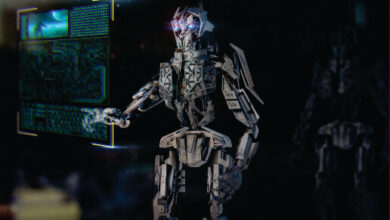Cyber Physical System vs IoT: What’s the Difference?
In our fast-paced, technology-driven world, the convergence of Cyber-Physical Systems (CPS) and the Internet of Things (IoT) is revolutionizing the way we live and work. These two interconnected domains are at the heart of the digital transformation that’s reshaping industries and our daily lives.
CPS and IoT are driving forces behind the interconnected, data-rich ecosystem we find ourselves in today. In this blog, we will delve into what CPS and IoT are, their key differences, and their myriad applications in various sectors.
Cyber-Physical System Vs. IoT
| Cyber-Physical System(CPS) | Internet of Things (IoT) |
|---|---|
| CPS is a system that integrates computational and physical components to monitor and control real-world processes. | IoT refers to a network of everyday objects and devices connected to the internet, enabling them to collect and exchange data. |
| CPS primarily focuses on optimizing physical processes and systems. | IoT is more about connecting everyday objects to the internet and gathering data. |
| CPS systems often operate within closed, controlled environments, such as manufacturing plants or healthcare facilities, where the interactions are tightly controlled. | IoT devices are designed to communicate with a broader range of devices and platforms, creating a more open and interconnected ecosystem. |
| CPS emphasizes real-time decision-making and control, enabling immediate responses to changes in the physical environment. | IoT is more about data collection, analysis, and reporting. It collects data from various devices and sensors, often for later analysis and decision-making. |
| CPS includes a strong physical component, with actuators and sensors playing a crucial role in directly influencing physical processes and systems. | IoT encompasses a wide range of devices, from smart thermostats and light bulbs to wearable fitness trackers and smart refrigerators. |
| CPS is prominent in sectors like manufacturing and healthcare, where real-time control and automation are vital for enhancing efficiency and safety. | IoT is prevalent in applications related to consumer convenience (smart homes), environmental monitoring (smart cities), and data analytics (e.g., collecting data for business insights). |
Defining Cyber-Physical Systems (CPS)
Cyber-Physical Systems (CPS) are intelligent, interconnected systems where the physical world meets the virtual one. These systems seamlessly integrate computational elements and physical components to monitor, control, and optimize processes. CPS brings automation and intelligence to industries, improving efficiency and decision-making.
Real-World CPS Applications
CPS has already left an indelible mark on several sectors. In the automotive industry, self-driving cars are a prime example. These vehicles combine sensors, actuators, and advanced software to navigate roads safely.
In healthcare, smart medical devices and telemedicine systems are transforming patient care through real-time monitoring and remote consultations. The industrial sector benefits from smart factories where CPS optimizes production and maintenance processes.
CPS enhances processes by providing real-time insights and control. It minimizes human intervention, increases efficiency, and reduces errors, making it a critical asset in various industries.
Understanding the Internet of Things (IoT)
The Internet of Things (IoT) is all about connecting everyday objects to the Internet, allowing them to collect and exchange data. Sensors and communication technologies are at the core of IoT, making it possible for devices to interact with each other and with us. This connectivity brings convenience and efficiency to our lives.
Data-Centric Nature
IoT is fundamentally data-centric. It collects vast amounts of data, which, when analyzed, provide valuable insights. This data-driven approach enhances decision-making, resource management, and overall efficiency.
IoT in Action
IoT devices are pervasive. In agriculture, IoT sensors monitor soil conditions and crop health, optimizing farming practices. Retail businesses leverage IoT for inventory management and customer insights, creating a seamless shopping experience.
In environmental monitoring, IoT helps gather data about air quality, weather, and more. These applications underscore the data-centric nature of IoT.
Key Differences between CPS and IoT
- Scope and Focus: CPS primarily focuses on optimizing physical processes and systems, while IoT is more about connecting everyday objects to the internet and gathering data.
- Interconnectedness: CPS systems often operate within closed, controlled environments, while IoT devices are designed to communicate with a broader range of devices and platforms.
- Data Handling: CPS emphasizes real-time decision-making and control, whereas IoT is more about data collection, analysis, and reporting.
- Physical Components: CPS includes a strong physical component, with actuators and sensors playing a crucial role. IoT, on the other hand, encompasses a wide range of devices, from smart thermostats to wearable fitness trackers.
- Applications: CPS is prominent in sectors like manufacturing and healthcare, where real-time control and automation are vital. IoT is prevalent in applications related to consumer convenience, environmental monitoring, and data analytics.
Future Trends and Integration
The future of CPS and IoT is filled with exciting possibilities. Edge computing, 5G connectivity, and AI integration are poised to reshape both domains. Standardization efforts are also underway to ensure seamless interoperability between different CPS and IoT devices.
Leveraging CPS and IoT:
For organizations, the key is to leverage the combined power of CPS and IoT to enhance performance and foster innovation. By integrating these technologies, businesses can unlock new opportunities, reduce costs, and improve the overall quality of their products and services.
Conclusion
So to wrap up this article, we can say that in the digital age, Cyber-Physical Systems and the Internet of Things are redefining the way we interact with the world around us. They are catalysts for automation, data-driven decision-making, and efficiency.
As these technologies continue to evolve, staying informed and adapting to their integration is crucial. Embrace the transformation, and be ready for a future where CPS and IoT play central roles in shaping our world.



